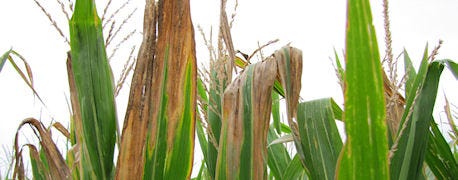July 29, 2013

Emmanuel Byamukama, South Dakota State University Extension plant pathologist, says that several research reports show increased yield from applying a fungicide on corn at tasseling when disease on the flag leaf at R5 is greater than 5%.
Several research reports show that increase in yield from fungicide application happens when disease severity on flag leaf at R5 is >5% (see the ISU publication), he says.

Goss's wilt is one of the diseases showing up at low levels in corn.
"Most of the corn scouted across the state looked very clean with no disease developing," Byamukama says. "Corn following corn or corn on no-till may have an elevated risk for significant disease to develop, depending upon the cultivar planted and weather conditions. Applying a fungicide at tasseling in this case may be beneficial."
Fungicide application should be done when all corn has fully tasseled to avoid arrested ear syndrome, a physiological disorder that is caused by nonionic surfactant fungicide additives when applied before tasseling (see Purdue University's Corn Disease Publication for details).
The corn plant pathology working group published a list of fungicides that are effective for several fungal pathogens on corn. This table can be downloaded online.
Byamukama and other SDSU Extension field specialists have noted that there are a number of diseases showing up at low levels in corn and soybeans now. They include:
Bacterial blight. The bacterial blight is characterized by small water-soaked spots on the lower leaves. These spots later turn yellow then brown to black in the center, with a yellowish-green halo around the spots. The brown spots may coalesce into blotches that may tear and fall out after windy weather, giving the leaves a ragged appearance Cool (<80° degrees F), wet weather favors the spread of the disease. Dry weather halts the spread of the disease up the plant. The bacteria survive on residue, therefore crop rotation and tillage may help reduce the severity of this disease.
Goss's wilt and blight. The presence of water soaked lesions and freckles are distinct symptoms for Goss's wilt. When the bacteria infects the vascular system, it blocks water-conducting tubes leading to wilting of the entire plant The bacteria overwinter on infested corn residue on soil surface and enter the plants through wounds created by hail, sand blasting, high winds and wounds created by insect feeding. Goss's wilt can be managed by selecting corn hybrids that are tolerant to this disease. If the field has history of Goss's wilt, selection of resistant/tolerant cultivars is the first step. Because the Goss's wilt pathogen survives on residue, tillage and crop rotation will reduce the inoculum. Fields at high risk are corn following corn and no-till/minimum till fields. Some weeds like foxtail, shattercane, and barnyard grass are hosts of the bacteria; therefore, early weed control is important to eliminate further sources of inoculum. Some products are being marketed for Goss's wilt control; however, there is insufficient data in the region on the efficacies of these products.
Common smut. Common smut on corn leaves was seen in a few fields that had hail damage. The fungal pathogen infects young, actively growing parts usually through wounds and forms galls. The fungus survives on crop debris or soil and can remain viable for several years. If the spores land on the silk, the fungus will infect the developing kernels resulting in galls on ears. Most corn hybrids have good resistance to common smut, however, corn on corn, no-till, and hail damage conditions may increase the risk for common smut infection on leaves.
For more information, see www.grow.org
Source: SDSU
You May Also Like




